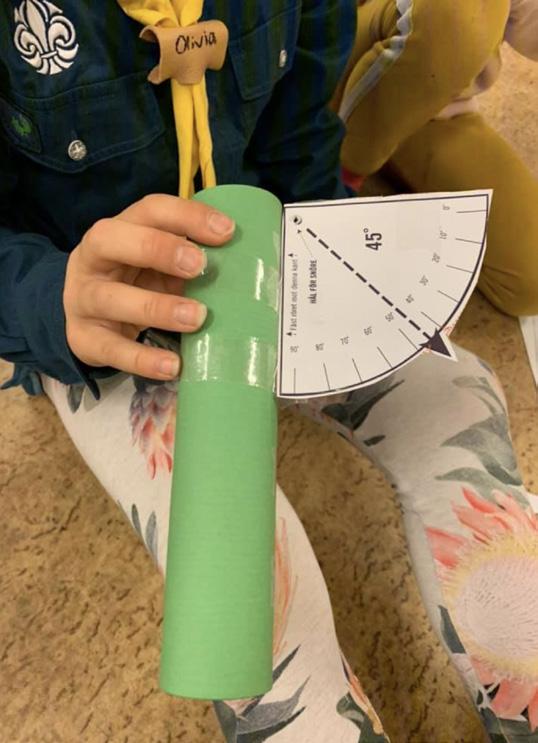
4 minute read
HOW THE CALCULATIONS WORK
7.
8. If you can’t see the sky in one of the directions (i.e. if a house, wall, or a tree is in the way) simply leave the box empty. Make a note of why a direction has not been recorded.
Write zero (0) if you can see the sky but do not observe any stars.
9.
Fill in information about the weather, the moon phase, the diameter and length of the tube in millimeters (mm), as well as the date and time of the observation in the app. 10. Allow your mobile to access your location. Check that the observation is in the right place on the map.
Participants could report their observations directly in the app when they were outside or choose to record their observations on paper and submit them via a web page on a computer.
Image 11. Observations were made at a 45-degree angle in different compass directions. Illustration: Hanna Mellin/VA On the Star-Spotting Experiment’s website were instructions, video clips, background material, a protractor template and a data collection template to print out on paper. https://forskarfredag.se/ star-spotting
S
N
SV
S NV
SÖ N
NÖ
Ö
Based on the number of stars each participant could see, a calculation was then made of how many visible stars were in the entire night sky at that particular time V
at that particular location. The more stars you could count through the tube, the more visible stars in the sky in total. The app did the calculation automatically and the participant was immediately informed how light-polluted it was at that location. A detailed explanation of how the calculations were made can be found below.
This is how the Star-Spotting Experiment app calculates how many visible stars there are in the whole sky at the time the observation is made:
When we have counted the number of stars in (a maximum of) nine different directions, the number of stars seen in each direction are labelled N1, N2 … up to N9.
The average number of stars (Navg) is calculated using the formula:
Navg = (NI + N2 + ... +N9) / 9.
12
The calculation of the number of visible stars in the entire sky is based on the assumption that the stars are evenly distributed across the sky. The larger the area of the sky we observe, the more stars we see. We can use this assumption to calculate how many stars are visible.
Let’s start from the beginning:
The length of the tube is L and its diameter is D. The area of the open end (A) is then:
A = π (D/2)2 = π D2/4
D
L
P H
Image 12. If you look at the sky through a tube, the rays of light entering the tube come from a much larger circular area in the sky. If the tube is pointed in every direction, it would eventually cover the surface of an ‘imaginary’ hemisphere above your head (H). Illustration: Lotta W Tomasson/VA
If you point the tube in lots of different directions up towards the sky, it would create an imaginary hemisphere (H) around where you are standing (see image 12).The radius of the hemisphere would then be the length of your tube, L. The area of the imaginary hemisphere H with a radius L is therefore:
H = 2 π L2
The area of the end of the tube can be projected and extended up into the night sky. Let’s call the projected image P, see image 12. The imaginary hemisphere can also be projected up into the sky into the earth’s hemisphere. This gives us the relationship:
Area of the hemisphere in the night sky = Area of H P A
or
Area of the hemisphere in the night sky = (2 π L2) = 8L2 Number of stars in H (π D2) D2 4
13
Finally, we go back to the assumption that we made at the beginning, that the number of stars is evenly distributed across the night sky. If this is true, it gives us the formula:
The total number of stars in the sky (Ntot) = Area of the hemisphere in the sky = 8L2 The number of stars in P Area of P D2
Which gives:
Ntot = 8L2 D2 * the number of stars you can see in the tube
How many stars is it even possible to see in the sky? According to the Yale Bright Star Catalogue8, there are 9,096 stars that are brighter than magnitude 6.5, which is considered to be the limit of what is visible to the naked eye. But we can only see half of space, because we can’t see what is on the other side of the earth. This reduces the number of stars we can see to 4,548. So, if the calculation ends up being a number greater than 4,548, it has either been calculated incorrectly in some way or something has gone wrong with the observation.
Using the calculation and the information about how many stars it is theoretically possible to see, you can calculate the level of light pollution. This is done by taking 1 minus the observed number of stars (Ntot) and dividing by 4,548:
Level of light pollution = 1 - Ntot / 4,548
where the degree of light pollution ranges from 1 (maximum light pollution) to 0 (no light pollution). Or as a percentage:
Level of light pollution = (1 - Ntot / 4,548) * 100
where the degree of light pollution ranges from 100 % (maximum light pollution) to 0 % (no light pollution).
Image 13. The degree of light pollution from 0% (no light pollution) to 100% (maximum light pollution). Illustration: Hanna Mellin / VA
8 A star catalogue published by the Yale University Observatory that lists and contains data about stars with a brightness greater than magnitude 6.5.









